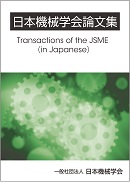Volume 85, Issue 870
Displaying 1-15 of 15 articles from this issue
- |<
- <
- 1
- >
- >|
Solid Mechanics and Materials Engineering
-
2019 Volume 85 Issue 870 Pages 18-00326
Published: 2019
Released on J-STAGE: February 25, 2019
Advance online publication: January 15, 2019Download PDF (2196K) -
2019 Volume 85 Issue 870 Pages 18-00327
Published: 2019
Released on J-STAGE: February 25, 2019
Advance online publication: January 15, 2019Download PDF (1958K) -
2019 Volume 85 Issue 870 Pages 18-00374
Published: 2019
Released on J-STAGE: February 25, 2019
Advance online publication: January 15, 2019Download PDF (2015K) -
2019 Volume 85 Issue 870 Pages 18-00409
Published: 2019
Released on J-STAGE: February 25, 2019
Advance online publication: January 31, 2019Download PDF (2363K)
Dynamics & Control, Robotics & Mechatronics
-
2019 Volume 85 Issue 870 Pages 18-00232
Published: 2019
Released on J-STAGE: February 25, 2019
Advance online publication: January 28, 2019Download PDF (3590K) -
2019 Volume 85 Issue 870 Pages 18-00249
Published: 2019
Released on J-STAGE: February 25, 2019
Advance online publication: January 17, 2019Download PDF (2205K) -
2019 Volume 85 Issue 870 Pages 18-00317
Published: 2019
Released on J-STAGE: February 25, 2019
Advance online publication: January 17, 2019Download PDF (2471K) -
2019 Volume 85 Issue 870 Pages 18-00360
Published: 2019
Released on J-STAGE: February 25, 2019
Advance online publication: January 28, 2019Download PDF (1564K)
Computational Mechanics
-
2019 Volume 85 Issue 870 Pages 18-00396
Published: 2019
Released on J-STAGE: February 25, 2019
Advance online publication: January 22, 2019Download PDF (2531K) -
2019 Volume 85 Issue 870 Pages 18-00441
Published: 2019
Released on J-STAGE: February 25, 2019
Advance online publication: February 07, 2019Download PDF (4290K)
Design, Machine Element & Tribology, Information & Intelligent Technology, Manufacturing, and Systems
-
2019 Volume 85 Issue 870 Pages 18-00222
Published: 2019
Released on J-STAGE: February 25, 2019
Advance online publication: January 31, 2019Download PDF (2314K) -
2019 Volume 85 Issue 870 Pages 18-00225
Published: 2019
Released on J-STAGE: February 25, 2019
Advance online publication: January 16, 2019Download PDF (2281K) -
2019 Volume 85 Issue 870 Pages 18-00293
Published: 2019
Released on J-STAGE: February 25, 2019
Advance online publication: January 16, 2019Download PDF (1502K) -
2019 Volume 85 Issue 870 Pages 18-00301
Published: 2019
Released on J-STAGE: February 25, 2019
Advance online publication: January 16, 2019Download PDF (2124K)
Bio, Medical, Sports and Human Engineering
-
2019 Volume 85 Issue 870 Pages 18-00430
Published: 2019
Released on J-STAGE: February 25, 2019
Advance online publication: January 28, 2019Download PDF (3571K)
- |<
- <
- 1
- >
- >|
